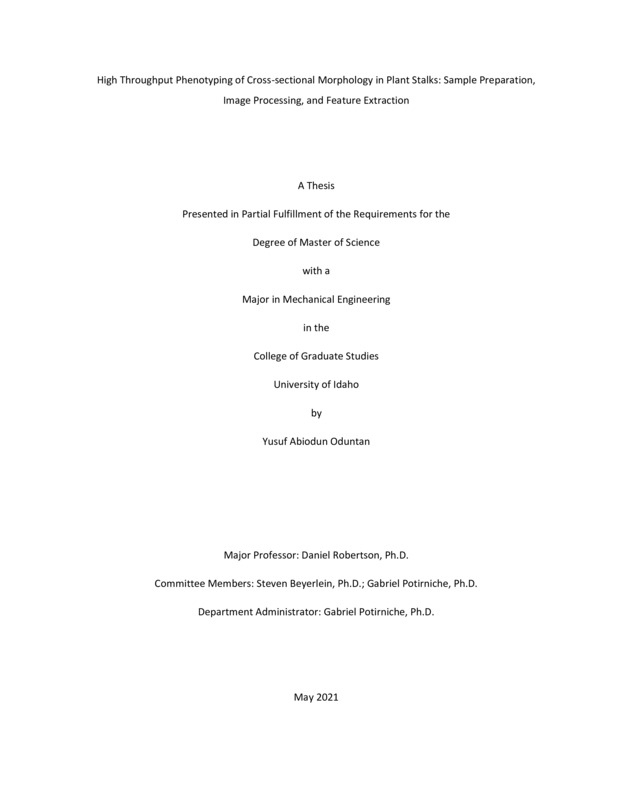High Throughput Phenotyping of Cross-sectional Morphology in Plant Stalks: Sample Preparation, Image Processing, and Feature Extraction
Oduntan, Yusuf Abiodun. (2021-05). High Throughput Phenotyping of Cross-sectional Morphology in Plant Stalks: Sample Preparation, Image Processing, and Feature Extraction. Theses and Dissertations Collection, University of Idaho Library Digital Collections. https://www.lib.uidaho.edu/digital/etd/items/oduntan_idaho_0089n_12015.html
- Title:
- High Throughput Phenotyping of Cross-sectional Morphology in Plant Stalks: Sample Preparation, Image Processing, and Feature Extraction
- Author:
- Oduntan, Yusuf Abiodun
- Date:
- 2021-05
- Keywords:
- Biomechanics Feature Extraction Finite Element Analysis Image Processing Sample Preparation Stalk Lodging
- Program:
- Mechanical Engineering
- Subject Category:
- Mechanical engineering; Engineering; Biomechanics
- Abstract:
-
Stalk lodging (mechanical failure of plant stalks during windstorms) leads to global yield losses in cereal crops estimated to range from 5-25% annually. The cross-sectional morphology of plant stalks is a key determinant of stalk lodging resistance. However, previously developed techniques for quantifying cross-sectional morphology of plant stalks are low-throughput, expensive and require specialized equipment and expertise. There is need for a simple and cost-effective techniques to quantify plant traits related to stalk lodging resistance in a high-throughput manner. To this end a rapid, low-cost, and user-friendly phenotyping methodology was developed to quantify two-dimensional plant cross sections. The methodology offers reduced sample preparation time and cost as compared to previously developed techniques. The new methodology employs an inexpensive stereoscope and a semi-automated image processing algorithm. The algorithm can be used to produce specimen specific, dimensionally accurate computational models (including finite element models) of plant stalks. This new methodology was applied to a range of plant samples including, maize (Zea mays), sorghum (Sorghum bicolor), wheat (Triticum aestivum), poison hemlock (Conium maculatum), and Arabidopsis (Arabis thaliana). The major diameter, minor diameter, rind thickness and number of vascular bundles were quantified for each of these plant types. Linear correlation analyses demonstrated strong agreement between the newly developed method and more time-consuming manual techniques (R2>0.9). In addition, the new method was used to generate several specimen specific finite element models of plant stalks. All of the models compiled without issue and were successfully imported into finite element software. All the models demonstrated reasonable and stable solutions when subjected to realistic applied loads.
- Description:
- masters, M.S., Mechanical Engineering -- University of Idaho - College of Graduate Studies, 2021-05
- Major Professor:
- Robertson , Daniel J
- Committee:
- Potirniche, Gabriel; Beyerlein, Steven
- Defense Date:
- 2021-05
- Identifier:
- Oduntan_idaho_0089N_12015
- Type:
- Text
- Format Original:
- Format:
- application/pdf
- Rights:
- In Copyright - Educational Use Permitted. For more information, please contact University of Idaho Library Special Collections and Archives Department at libspec@uidaho.edu.
- Standardized Rights:
- http://rightsstatements.org/vocab/InC-EDU/1.0/

